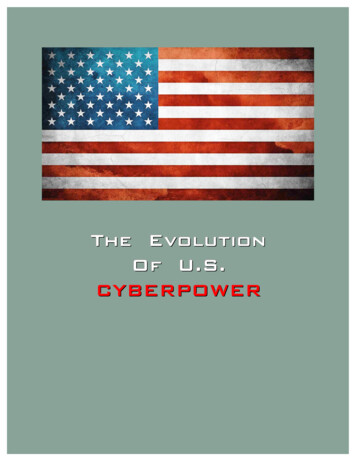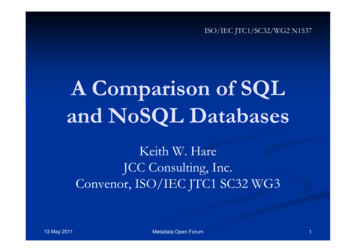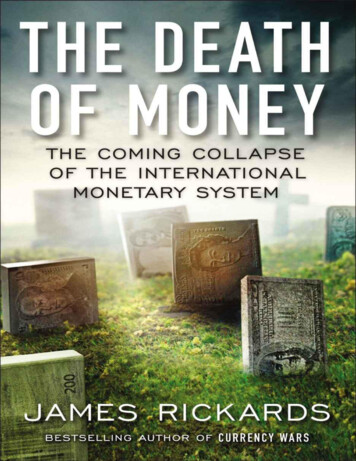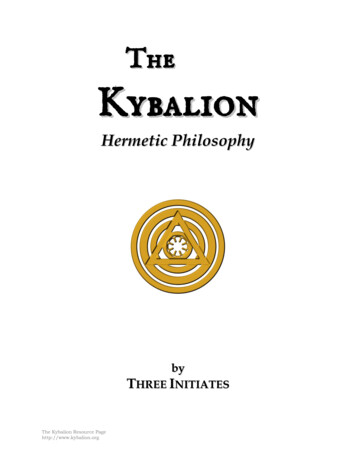
Transcription
The EvolutionOf U.S.CYBERPOWER
iiThe Evolution of U.S. CyberpowerABSTRACTHow has the United States dealt with cyber attacks in the past? How should we dealwith cyber attacks in the future? This paper will analyze the cyber events that tookplace during four kinetic conflicts to answer these questions: the Desert Stormcampaign, the Allied Force operation, the Unified Protector conflict, and finally, theGlobal War on Terror.During the research, it was discovered that, for the purposes of this paper, nosatisfactory definition of cyberspace existed, so as a first step a new definition wascreated. The case studies analyzed revealed several important lessons. Desert Stormdemonstrates that quick responses and the sharing of information between institutionsare critical. The Operation Allied Force case reveals that every kinetic conflict will likelyhave cyber elements. Operation Unified Protector illustrates that it only takes a smallcyberforce to have major influence in a conflict. Finally, since the advent of War onTerror there has been an increase in the number and sophistication of cyber attacks.The recommendations proposed in this paper are drawn directly from the casestudies themselves. The key recommendations being that a separate military service isnecessary for cyber supremacy, cyber warfare should be dealt with as guerrilla warfare,and non-conventional tactics may be the most effective.
The Evolution of U.S. CyberpowerTable of ContentsIntroduction .1Purpose . 1Definitions . 1History . 7Case Studies .11Desert Storm 1990 . 11Allied Force 1999 . 18Unified Protector 2011. 23Global War on Terror 2001-Present . 27Conclusion .33Summary . 33Recommendations. 34Final Thoughts . 37Bibliography .38iii
The Evolution of U.S. Cyberpower1IntroductionPURPOSEThe Evolution of U.S. CyberpowerThe twofold purpose of this paper is to provide a systematic framework for analyzingthe history of the cyber security domain, and to examine certain weaknesses in cybersecurity practices. As a foundation for understanding cyber security issues, the DesertStorm (1990), Operation Allied Force (1999), Operation Unified Protector (2011), andthe Global War on Terror (2001-present) case studies will be scrutinized. By providinga clear, concise picture of the events that transpired in each of these case studies, andby drawing logical conclusions from them, we glean important strategic lessons. Thecumulative results will be used to formulate recommendations for future strategies andtactics in cyberspace security.DEFINITIONS“Imprecision in terminology hampers serious discussion of these issues.”James A. Lewis, Center for Strategic and International Studies1Defining CyberspaceBefore introducing any case studies, it is important to clearly define the term“cyberspace.” The modern interpretation of the word “cyber” and its use as a prefix is afairly recent phenomenon; however, despite the relative infancy of the term, it has been1James Andrew Lewis, Thresholds for Cyberwar, ed. Center for Strategic andInternational Studies, page 1, accessed June 4, ar.
The Evolution of U.S. Cyberpower2accepted industry-wide as a way of indicating anything electronic or computer related.The term “cyberspace” has also become synonymous with the concept of a digitalvirtual domain, especially the Internet.As the cyber domain has become an increasingly critical component in modern life,several leading organizations have attempted to establish a definition for the word“cyberspace,” including the CIA, the NSA, the Russian-American Cyber SecuritySummit, and the oft-cited U.S. Department of Defense. However, the novelty andrapidly changing nature of the domain have hampered consensus. Definitions withinthe various organizations continue to evolve over time to better fit the developingconcept of cyberspace. The following are two recent definitions for cyberspace, putforward by leading sources, illustrating the challenge of clear definition:U.S. Department of Defense:“A global domain within the information environment consisting of theinterdependent network of information technology infrastructures, including theInternet, telecommunications networks, computer systems, and embeddedprocessors and controllers.”2Russian-American Cyber Security Summit:“An electronic medium through which information is created, transmitted, received,stored, processed, and deleted.”32Department of Defense Dictionary of Military and Associated Terms, jointpublication 1-02 ed. (2010), page 83, by Office of the Joint Chiefs of Staff,accessed June 4, 2012, last modified March 15, 2012,http://www.dtic.mil/doctrine/new pubs/jp1 02.pdf.3East West Institute and Information Security Institute of Moscow StateUniversity, The Russia - U.S. Bilateral on Cybersecurity - CriticalTerminology Foundations, ed. Karl F. Rauscher and Valery Yaschenko, Issue 1
The Evolution of U.S. Cyberpower3While these are excellent definitions, and each captures many elements associatedwith cyberspace, neither is complete. This paper will attempt to present a new, morecomprehensive definition. The primary challenge is to follow a logical and realisticframework of thought, while avoiding the trap of attempting to include every smallelement of the cyber domain. It is necessary to be simultaneously thorough andconcise, to avoid a definition so wordy as to render it useless.The pursuit of a definition for cyberspace in this paper will be based primarily on anexamination of vulnerabilities in the cyber domain. These vulnerabilities, by their verynature, tend to illuminate critical, observable, and definable aspects of the cyber world.Therefore, as a first step in constructing a definition for cyberspace, it is useful todescribe the types of attacks to which the cyber domain is vulnerable. The GovernmentAccountability Office (GAO) presents a fairly comprehensive list and description ofvulnerabilities in their Congressional report, CYBERSPACE - United States FacesChallenges in Addressing Global Cybersecurity and Governance.4 The descriptionsfrom the GAO congressional report are given in Table 1.1.(2011), page 1, accessed June 4, 2012, le/32.4Government Accountability Office, Report to Congressional Requesters:CYBERSPACE - United States Faces Challenges in Addressing GlobalCybersecurity and Governance, GAO-10-606, page 5, accessed June 4, 2012,http://gao.gov/products/GAO-10-606.
The Evolution of U.S. Cyberpower4Table 1.1 GAO List of Cyber AttacksNameDescriptionDenial of serviceA method of attack from a single source that denies systemaccess to legitimate users by overwhelming the target computerwith messages and blocking legitimate traffic. It can prevent asystem from being able to exchange data with other systems oruse the Internet.Distributed denial ofserviceA variant of the denial of service attack that uses a coordinatedattack from a distributed system of computers rather than from asingle source. It often makes use of worms to spread to multiplecomputers that can then attack the target.Exploit toolsPublicly available and sophisticated tools that intruders of variousskill levels can use to determine vulnerabilities and gain entryinto targeted systems.Logic bombsA form of sabotage in which a programmer inserts code thatcauses the program to perform a destructive action when sometriggering event occurs, such as terminating the programmer’semployment.PhishingThe creation and use of e-mails and Web sites—designed tolook like those of well-known legitimate businesses, financialinstitutions, and government agencies—in order to deceiveInternet users into disclosing their personal data, such as bankand financial account information and passwords. The phishersthen use that information for criminal purposes, such as identitytheft and fraud.SnifferSynonymous with packet sniffer. A program that interceptsrouted data and examines each packet in search of specifiedinformation, such as passwords transmitted in clear text.Trojan horseA computer program that conceals harmful code. A Trojan horseusually masquerades as a useful program that a user would wishto execute.VirusA program that infects computer files, usually executableprograms, by inserting a copy of itself into the file. These copiesare usually executed when the infected file is loaded intomemory, allowing the virus to infect other files. Unlike a computerworm, a virus requires human involvement (usually unwitting) topropagate.
The Evolution of U.S. Cyberpower5VishingA method of phishing based on voice-over-Internet-Protocoltechnology and open-source call center software that have madeit inexpensive for scammers to set up phony call centers andcriminals to send e-mail or text messages to potential victims,saying there has been a security problem, and they need to calltheir bank to reactivate a credit or debit card, or send textmessages to cell phones, instructing potential victims to contactfake online banks to renew their accounts.War drivingA method of gaining entry into wireless computer networks usinga laptop, antennas, and a wireless network adapter that involvespatrolling locations to gain unauthorized access.WormAn independent computer program that reproduces by copyingitself from one system to another across a network. Unlikecomputer viruses, worms do not require human involvement topropagate.Zero-day exploitA cyber threat taking advantage of a security vulnerability on thesame day that the vulnerability becomes known to the generalpublic and for which there are no available fixes.In total, the GAO presents twelve types of attacks. Upon closer examination, apattern emerges which allows the twelve attacks to be simplified further by groupingthem into fewer but broader categories. The twelve types of attacks resolve into threecategories, based upon the nature of the vulnerability. Table 1.2 illustrates the pattern.Table 1.2 The Three Categories of Cyber AttacksAttacks TargetingHardware(Kinetic)Denial of Service (DOS)Distributed DOSAttacks TargetingSoftware(Hacking)Exploit ToolsLogic BombsSnifferTrojanVirusWormZero-DayAttacks TargetingHumans(Espionage)PhishingTrojanVishing
The Evolution of U.S. Cyberpower6Based on Table 1.2, cyberspace consists of three elements, hardware, software, andhumans, each of which is vulnerable to attack. Some might immediately insist a keyelement is missing from this description -- information -- that is, the content exchangedbetween each of the three elements. However, as defined in this paper, information isregarded as the commodity moving THROUGH the system, rather than as an elementof the system itself. In this framework, manipulation of information is seen as thePURPOSE of cyberspace, not an element of it. This key distinction allows us to isolatethe non-virtual and defensible infrastructure from the incorporeal and indefensiblecommodity within the system.The following definition for cyberspace emerges in this framework:CyberspaceA virtual domain created by the union of three non-virtual agents: hardware,software, and humans – for the purpose of manipulating information.
The Evolution of U.S. Cyberpower7HISTORYHaving defined a framework for the discussion of cyber security issues, it is useful toreview a general history of cyberspace before moving on to specific case studies.Decade by decade, we briefly recount the evolution of major milestones in cyberspacehistory, focusing primarily on events in the United States.1920's Arguably, the first instance of "cyberspace" usage (according to the definitionabove) was in 1926, when the German Navy began using the Enigma Machine,invented by German engineer, Arthur Scherbius. The Enigma Machine was anelectro-mechanical encryption device, which combined hardware and software(crude by today’s standards, but nevertheless, they were algorithms in the formof rotors), with human operators for the purpose of manipulating information.51930's Interestingly, in the United States, the Navy was also the first military branch toadopt a device similar to the Enigma Machine, dubbed SIGABA, in the late1930's. By the end of World War II, cipher machines were in widespread use.6 Also in the late 1930's, another German inventor, by the name of Konrad Zuse,designed the first freely programmable mechanical computer, called the Z1.75Tony Sale, "The Breaking of German Naval Enigma ," Naval Enigma Index,accessed June 4, avenigma/navenig1.htm.6Richard Pekelney, "What Is The SIGABA-ECM Mark II and Why It Was Important?"Crypto Machines, accessed June 4, 2012, last modified April 30, 2012,http://www.jproc.ca/crypto/ecm2.html.
The Evolution of U.S. Cyberpower81940's The first electronic digital computer, the Atanasoff-Berry Computer (ABC),pioneered several crucial components of modern computing; including electronicswitch features and the ability to do binary arithmetic.8 Probably the single most important development in computing, the transistor,was designed in AT&T's Bell Labs, in 1947 by John Bardeen and WalterBrattain.91950's IBM drafted the first "high level" computer language, FORTRAN, in 1954-1957,with a team of assembly language programmers, headed by John W. Backus.10 Another historic cyber milestone reached in the 1950's was the development ofthe integrated circuit chip. The development of the IC chip had several notablecontributors; including, Geoffrey Dummer and then later Jack Kilby, ultimatelyculminating in the development of the silicon chip by Robert Noyce in 1959.117Complete Dictionary of Scientific Biography (Encyclopedia.com, 2008), s.v."Zuse, Conrad," accessed June 4, 2012, .8Encyclopedia of World Biography (Encyclopedia.com), s.v. "John Atanasoff,"accessed June 4, 2012, last modified 4.html.9Complete Dictionary of Scientific Biography (Encyclopedia.com), s.v."Bardeen, John," accessed June 4, 2012, last modified 2008,http://www.encyclopedia.com/topic/John Bardeen.aspx.10Ian Chivers and Jane Sleightholme, Fortran History and Development, page 1,accessed June 4, n history and development.pdf.11Encyclopedia of World Biography (Encyclopedia.com), s.v. "Robert Noyce,"accessed June 4, 2012, last modified 1.html.
The Evolution of U.S. Cyberpower1960's Developed as a defense project by the Advance Research Projects Agency, theARPAnet was the first computer network to use a technique called packetswitching, a type of information transfer that allowed more than onecommunication exchange to occur on the same phone line at the same time.BBN Technologies was awarded a contract to build the first network in 1969.This network was the direct ancestor of the modern Internet.121970's In 1975, the first commercial packet-switching network available to the generalpublic went into service: Telenet.13 ARPAnet also began merging with other networks in the mid 1970's. Thismerging of networks was referred to as the internetwork, which was replaced bythe shortened and more familiar term, the Internet.141980's DoD declared the TCP/IP protocol to be the official military network standard in1982.1512Gale Encyclopedia of E-Commerce (Encyclopedia.com), s.v. "ARPAnet,"accessed June 4, 2012, last modified x.13Janet Abbate, "Government, Business, and the Making of the Internet,"Business History Review 75, no. 1 (Spring 2001): 164.14Ibid, 165.15Computer Sciences (Encyclopedia.com), s.v. "TCP/IP," by William J. Yurcik,accessed June 4, 2012, last modified 4.html.9
The Evolution of U.S. Cyberpower10 In 1983, the DoD split the ARPAnet into two networks: ARPAnet and MILnet.16 The first .com domain name was registered on March 15, 1985 by Symbolics Inc.Symbolics.com is the first and oldest registered commercial domain name on theInternet.17 In 1988, the first Internet wide virus, known as the Morris Worm, took advantageof a simple security flaw, and wreaked significant havoc.181990’s ARPAnet is officially decommissioned in 1990.19 The World Wide Web protocol, developed by Tim Bernes-Lee is release in1991.20 Two Stanford students, Larry Page and Sergey Brin, registered Google.com onSeptember 15, 1997, to host their new search engine.16Janet Abbate, Inventing the Internet (Cambridge, Massachusetts: MIT Press,2000), 185.17Robin Wauters, "25 Years Later, First Registered Domain Name ChangesHands," AOL Tech, accessed June 4, 2012, last modified August 27, ited States of America v. Robert Tappan Morris, No. 90-1336 (2d Cir.March 7, 1991), accessed June 4, 2012,http://www.loundy.com/CASES/US v Morris2.html.1920Gale Encyclopedia of E-Commerce , 2002.Encyclopedia of World Biography (Encyclopedia.com), s.v. "Tim Berners-Lee,"accessed June 4, 2012, last modified 5.html.
The Evolution of U.S. Cyberpower11Case StudiesDESERT STORM 1990“Nothing is more important in war than unity in command.”Napoleon Bonaparte21In the history of cyber attacks against the United States, the incidents that occurred in1990 in conjunction with the events of the Desert Storm campaign stand out asparticularly dramatic and severe. The case bears all the hallmarks of a highlysuccessful attack, and had Saddam Hussein been slightly more cyber-savvy, he couldwell have altered the outcome of the Desert Storm/Desert Shield conflict.To fully appreciate the nature of the 1990 cyber attack, it is necessary to place thespecific events of the attack within the broader context of the progress of cyberevolution at the time. One of the main challenges of the very early Internet era, in the1980’s, was compatibility between network elements. At the time, industry views on theeconomic viability of networking varied, and by extension, so did the practicalapplications. There were multiple companies and universities simultaneously buildingcomputers and networks, and each organization had its own protocol for interconnectingnetwork elements.22 To resolve the issue of incompatibility, gateway computers were21National Defense University, editorial, Joint Force Quarterly, April 2005,page Inside Cover, accessed June 4, 7.pdf.22Abbate,(Spring 2001): 164.
The Evolution of U.S. Cyberpower12developed that could interface with all of these networks. These gateways were placedbetween each network to interpret and relay signals.23Eventually, endeavoring to keep the gateway computers compatible with everyexisting and developing network became too complicated to maintain. To remedy thesituation, the Defense Advanced Research Projects Agency (DARPA) created a newnetwork transmission method that nested specific network protocols into a singlecommon protocol. This new protocol became known as TCP/IP. It was named after theTransmission Control Protocol (TCP) and the Internet Protocol (IP), and it transferredthe responsibility for reliable compatibility to each end/host node, and away from thecentral network. It was officially adopted as the military network standard in 1982. Thisnew system allowed ARPAnet to effectively connect with practically any industrynetwork, regardless of the protocol, and revolutionized cyber connectivity. However,this increased connectivity introduced an inherent security breach, due to the largenumber of nodes brought together into a single network.24In 1983, the DoD separated the military portion of its network from the publicARPAnet, and the new network was called MILnet.25 MILnet was intended to be moresecure than its civilian counterpart, but the DoD didn't want complete separation. Toachieve security of MILnet without complete separation, the DoD installed highly securegateway computers between ARPAnet and MILnet, believing this would prevent23Janet Abbate, (2000), 128.24Mukundan Venkataraman, Kartik Muralidharan, and Puneet Gupta, Designing newArchitectures and Protocols for Wireless Sensor Networks: A Perspective, ed.IEEE Communications Society, page 38, accessed June 4, 2012,http://www.cs.ucf.edu/ mukundan/secon05.pdf.25Abbate, (2000), 128.
The Evolution of U.S. Cyberpower13hackers from gaining a quick access point into the different networks. This turned out tobe a simplistic view of network security, and unwittingly exposed MILnet to a kind of“springboard effect” security flaw created by the adoption of the TCP/IP.Hackers learned how to gain outside control of individual computers fairly early, andas single computers began to be connected through networks and gateway computers,they found ways to take advantage. Four security flaws, which by today's standards arerelatively archaic, were exploited in 1988 by the first "internet-wide" worm, the infamousMorris Worm, a program written by a Cornell University student, Robert Tappan Morris.The Morris Worm exploited vulnerabilities in SEND MAIL, Finger, "trusted host"privileges, as well as password guessing.26Using these simple security loopholes to gain control of a host computer, the MorrisWorm would then send itself to other computers on the same network. The gatewaycomputers had security measures in place to prevent someone from gainingunauthorized access; however, they didn’t necessarily regulate the information beingpassed through. Therefore, if the worm controlled a host on one network, it couldsimply springboard to the next network without overcoming any defensive measures onthe gateway computers. Due to the Morris Worm’s self-propagating nature, it causedconsiderable strain on computers, and essentially became the first distributed denial ofservice (DDOS) attack on any network, causing widespread server failure. Theintroduction of TCP/IP technology provided even broader opportunities to these existingsecurity flaws.26United States of America v. Robert Tappan Morris, No. 90-1336 (2d Cir.March 7, 1991), accessed June 4, 2012,http://www.loundy.com/CASES/US v Morris2.html.
The Evolution of U.S. Cyberpower14These historical events lead us directly into the Desert Storm case study and theincidents that unfolded in 1990. Two years after the Morris Worm incident, the samesecurity loopholes still existed, with very few updates to defense mechanisms, andcyber attackers again exploited precisely the same vulnerabilities. These loopholeswere compounded by the increased connectivity of TCP/IP and allowed a group ofhackers based out of the Netherlands to gain control of server hosts in the ARPAnet,and then to use those hosts as a springboard into the MILnet. Security expert, AndrewLandsman describes the attacks very well.The first indications of the widespread break-ins into MILnet hosts were from logentries in Department of Energy (DoE) machines. The attackers broke into DoEmachines using what now seems like very rudimentary attack methods, includingpassword guessing (or sometimes even using null passwords), exploiting a VMSvulnerability in the SYSMAN utility, exploiting trust relationships between hosts, and afew others. Once they gained access to a host, they often already had super-userprivileges, but if they did not, they exploited other vulnerabilities to take completecontrol of the victim systems. They then installed back doors. By breaking into hostsat DoE sites such as Los Alamos National Laboratory, Lawrence Livermore NationalLab, Fermi National Lab, Sandia National Lab, and Brookhaven National Lab, theattackers had more than enough springboards from which they could launch attacksagainst MILnet hosts at military centers such as US Navy Headquarters, the PacificFleet Command, Rome Air Force Base, Kelly Air Force Base, the Pentagon, andmany more, which they did successfully day after day for well over a year.
The Evolution of U.S. Cyberpower15Once the attackers broke into DoD hosts, they used commands such as grep inUnix systems to discover files that contained the information they desired: informationabout military equipment, weapons systems, troop and warship movements(especially in connection with Operations Desert Storm and Desert Shield) and muchmore—they often even searched for “nuclear.” The attackers stole so muchinformation that they quickly filled the hard drives of their own machines. They thenresorted to downloading huge amounts of information onto systems at the Universityof Chicago and Bowling Green University.27The worst part of the fiasco was that the DoE’s Computer Incident AdvisoryCapability (CAIC) noticed and reported the attacks to the DoD; in fact, CERT/CC alsoreceived similar reports. Landsman explains, “At one point the DoD, DoE, U.S. Navy’sincident response team, the National Security Agency, the US State Department, theNational Institute of Standards and Technology (NIST), the Central Intelligence Agency,the Air Force Office of Special Investigations, Army Intelligence, the Federal Bureau ofInvestigation, CIAC and CERT/CC were involved. Cooperation and coordination wereextremely difficult to obtain, but despite many obstacles (most of them political andbureaucratic in nature), these entities managed to conduct reasonably successfulinvestigation efforts.”28 In all fairness, organizing and executing an effective approachto dealing with cyber security breaches was a relatively new operation.27Andrew Landsman, "A Short and Shortsighted History of Hacks: Part 1 – TheDesert Storm/Desert Shield Attacks," Network Security Consulting Blog, May12, 2009, accessed June 4, 2012, esertstormdesert-shield-attacks/.28Ibid.
The Evolution of U.S. Cyberpower16Fortunately, the criminals were not politically motivated. Instead the hackers tried tosell the information to Saddam Hussein for one million dollars. Hussein, for whateverreason, never took them up on the offer, possibly thinking it a hoax. Needless to say,had he done so, the Desert Storm conflict may have taken a drastically differentcourse.29A New York Times article published in 1991, which cited computer experts whoreconstructed the 1990 attacks using key logs of the hackers' activities, drew thisconclusion: "The tactics of the group are of particular interest to computer securityexperts because members have repeatedly used security loopholes demonstrated by aprogram written by Robert Tappan Morris, a Cornell University student, more than twoyears ago."30 The reconstructed attacks provide ample evidence of the correlationbetween the Morris Worm attack of 1988 and the cyber-attacks during Desert Storm in1990. The two attacks were so similar that one expert stated, "It looked like (theattacker) had a cookbook sitting next to him telling him what to do next at each step."31The Gulf War cyber attack incident illustrates a central difficulty facing institutions andgovernments with regard to cybersecurity management. Experience indicates that"lessons learned" must be implemented rapidly in the cyber arena. If not, enemies will29Nelly Favis Villafuerte, "The Reality of Cyber Terrorism," Manila BulletinPublishing Corporation, accessed June 4, 2012, last modified March 25, ity-cyber-terrorism.30John Markoff, "Dutch Computer Rogues Infiltrate American Systems WithImpunity," New York TImes, April 21, 1991, accessed June 4, nity.html?pagewanted all&src pm.31Ibid.
The Evolution of U.S. Cyberpower17have the opportunity to exploit vulnerabilities. As stated in the New York Times articleat the time: "The fact that the same security flaws can be used to illicitly entercomputers several years after they were widely publicized indicates that manyprofessional computer managers are still paying only minimal attention to protecting thesecurity of the information contained on the computers they oversee."32If cyber incidents had become less frequent today than in the early 1990s, one mighthave hope. However, attacks today are only more complex and more frequent, whilethe pace of institutional responses continues to lag the accelerating rate of the problem.Large institutions continue to have inherently slow decision-making processes, withresponsibility for implementing change divided across many competing, internal powercenters.32Ibid.
The Evolution of U.S. Cyberpower18OPER
Russian-American Cyber Security Summit: "An electronic medium through which information is created, transmitted, received, stored, processed, and deleted."3 2 Department of Defense Dictionary of Military and Associated Terms, joint publication 1-02 ed. (2010), page 83, by Office of the Joint Chiefs of Staff,










